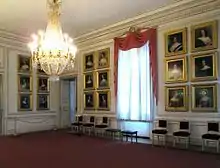

The Gallery of Beauties (German: Schönheitengalerie) is a collection of 36 portraits of the most beautiful women from the nobility and bourgeoisie of Munich, Germany, painted between 1827 and 1850 (mostly by Joseph Karl Stieler, appointed court painter in 1820) and gathered by Ludwig I of Bavaria in the south pavilion of his Nymphenburg Palace in Munich.[1] Two additional portraits were created by Friedrich Dürck, a student of Stieler. Its best-known works are the portraits of the shoemaker's daughter Helene Sedlmayr, the actress Charlotte von Hagn (revered by audiences in Munich, Berlin and Saint Petersburg) and the king's Irish mistresses Eliza Gilbert (Lola Montez) and Marianna Marquesa Florenzi. They include a Briton, a Greek, a Scot and an Israelite, along with relations of Ludwig's – the wife and daughter of Ludwig of Oettingen-Wallerstein were both painted, as was Ludwig I's daughter Princess Alexandra of Bavaria. All 36 women pictured were rewarded for modeling by Ludwig I. He took over their dowry, paid them an allowance or found them a job at court. He remained in active correspondence with some of them for years, while others only briefly crossed his life.[2]
Previous collection
The idea of collecting paintings of beautiful women in a gallery was not an invention of Ludwig I of Bavaria, but seems to have originated in Italy. According to the earliest records, one of the Margraviate of Mantua is said to have owned such a collection in the 17th century. Something similar is reported from the courts of Ferdinand II, Archduke of Austria in Ruhelust Castle (Hofgarten, Innsbruck), and Lorenzo Onofrio Colonna, 8th Prince of Paliano in Carnesino Castle (near Como).[3]
In England there are the Windsor Beauties, eleven of the ladies of King Charles II of England's court painted by Sir Peter Lely in the 1660s, and the Hampton Court Beauties, a later set by Sir Godfrey Kneller.
The gallery of originally 40 works that the Bavarian Electress Princess Henriette Adelaide of Savoy had created between 1650 and 1675 by her Munich court painter who had a much greater influence on Ludwig I. The gallery probably first hung in the old Schleissheim Castle and can now be found at least in part in the vestibule of the Cuvilliés Theater in Munich. The motifs are allegories of alleged ladies- in-waiting of Princess Henriette.
Not only Ludwig I, but also Princess Henriette's son, Maximilian II Emanuel, Elector of Bavaria, was inspired by these works. In his gallery of beauties there were the most beautiful ladies of the French court from the times of King Louis XIV. The latter could also come from Princess Henriette Adelaide's gallery.
Elector August II of Saxony had several galleries with beauties in Pillnitz Castle: one with ladies-in-waiting of Mary II of England, created by students of Anthony van Dyck, one by Pietro Rotari (1707–1762), whom he invited to Dresden in 1750, and possibly another one with beautiful Polish women.
In all of the beauty galleries mentioned so far, there is no discernible relationship between the ruler and the subject. William VIII, Landgrave of Hesse-Kassel had Johann Heinrich Tischbein paint 28 beauties – 14 bourgeois ones for the first anteroom of Wilhelmsthal Palace, 14 noble ones for the second one, which is closer to him. These models were known to Wilhelm VIII; they were not portraits (or even copies of existing works) of ladies from other courts unknown to him, as had been common in previous beauty galleries.
Probably the largest gallery of beauties comes from Pietro Rotari. Tsarina Elizabeth of Russia commissioned the painter from Verona, who had been her court painter since 1756, to create a cabinet of fashions and graces. He was supposed to paint young women who represented the diversity of Russian people. As part of this commission, Rotari not only created 360 pictures of middle-class Russian women for the Tsarina, but also an additional 50, which she gave away to the Russian Academy of Art. The Tsarina's pictures were intended for Peterhof Palace. Today around 40 of the works can be found in Arkhangelskoye Palace near Moscow.
Origin

Before the Gallery of Beauties was created, there was a small scandal around 1817 because of two works by Joseph Karl Stieler. He had painted a portrait of Countess Rambaldi, one of the king's mistresses, for Ludwig I. This souvenir image, which allegorically depicts the Countess as a Madonna in order to anonymize her, it was hung next to a portrait of Ludwig I when he was a Crown Prince. However, the public recognized the motif and was outraged. The portrait of the crown prince, which Nathanael von Schlichtegroll described as a “masterpiece” in a letter to Georg Issel, was then removed.
The excitement over this picture was probably one of the reasons why Ludwig I decided to create a more anonymous gallery, which was first mentioned in 1821. At this point, Stieler, still a court painter without a fixed salary, offered pictures of Madame Lang and an Italian opera singer, Adelaide Schiasetti for Ludwig's collection of beautiful heads. However, both works did not make it into the gallery.[4] However, Ludwig I acquired it in 1823 for the Munich art exhibition. According to the king's will, the gallery was to be primarily a collection of patriotic beauties, although foreign women were also represented; and from their posterity should be able to recognize how the character of female beauty was expressed at that time.[5]
When Ludwig I began his expansion of the Munich Residence in 1826, he planned the rooms in which the collection would be hang. The plan for the rooms called for red and green stucco marble in wide, horizontal layering for the walls, which were to be finished with a base zone of around 80 centimeters. The coffered ceiling and door panels were decorated with tendril ornaments. In 1828, in a letter to Johann Georg von Dillis, he named the first ten works that were to be exhibited in the two conversation rooms under construction:
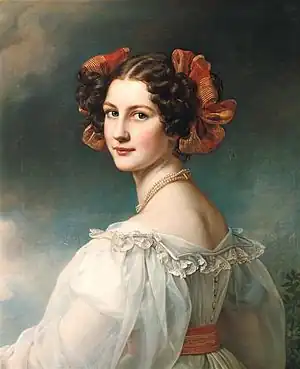
- Marianna Marquesa Florenzi
- Countess Isabella of Tauffkirchen-Engelberg
- Charlotte von Hagn
- Auguste Strobl (2)
- Antonietta Cornelia Vetterlein
- Maximiliane Borzaga
- Nanette Kaulla
- Regina Daxenberger
- Anna Hillmayer
These ten pictures were also presented to the public in 1829 as part of an art exhibition together with Stieler's portrait of Goethe. However, the picture of Nanette Kaulla was not yet finished at this point. In addition to these ten portraits, others were added, so that when they moved in in 1835, 17 portraits that had been created over the last eight years or so could be exhibited:
- Amalie Adlerberg
- Jane Digby
- Amalia von Schintling
- Helene Sedlmayr
- Princess Crescentia of Öttingen-Öttingen and Wallerstein
- Marquise Irene of Pallavicini
- Caroline von Holnstein
.jpg.webp)
Over the next 15 years until 1850, Stieler completed the missing 19 portraits and completed his work with the portraits of Lola Montez and Maria Dietsch. Cosmetic corrections were made to the latter because in Stieler's opinion, Dietsch was “not an excellent beauty”.
The painter also had difficulties with his penultimate work for the gallery, the portrait of Lola Montez: he feared the reaction of the public, which did not have much use for Montez. Ludwig I had to ask him to paint her several times in 1846. He ended up painting her in the costume of a Spanish dancer, with a relatively bare upper body and a mask in her hand. Ludwig I was outraged by the motif and had it painted again in black velvet. The king was also not enthusiastic about the result of Stieler's work, whose motivation was rather low: “Your brush is getting old ,” criticized Ludwig I. Stieler replied to the king: “But nice enough for an old brush.”[6][7]
This also applied to Marianna Marquesa Florenzi from Florence, from whom Ludwig I repeatedly sought advice, including on state matters. When she was told that the picture of this Lola Montez was now hanging next to her portrait, she categorically demanded in one of her 3,000 letters to him (he wrote her about 1,500) that her picture be taken down and threatened to withdraw her favor from him otherwise.[8]
In 1861, Ludwig I commissioned Stieler's nephew and student Friedrich Dürck (1809–1884) to create two more portraits for the collection. This is how the only two pictures in the collection that did not come directly from Stieler were created: Anna von Greiner and Carlotta von Breidbach-Bürresheim.
Since the ballroom building was destroyed during the Second World War, the collection moved to the small dining room at Nymphenburg Palace. The original plan was to have their resume their place in the residence soon.
List of the Beauties
A list of the portraits follows:
| Name | Life | Husband(s) | Dimensions | Year | Image |
|---|---|---|---|---|---|
| Auguste Strobl | (1807–1871) | Anton Hilber, forester (⚭ 1831) | 72,5 x 59,2 cm | 1827 |  |
| Maximiliane Borzaga | (1806–1837) | Joseph Krämer, doctor in Kreuth (⚭ 1830) | 72 x 58 cm | 1827 |  |
| Isabella Countess of Tauffkirchen-Engelberg | (1808–1855) | Count Hektor von Kwilecky auf Kwilcz (⚭ 1830) | 72 x 59,8 cm | 1828 |  |
| Amalie von Lerchenfeld | (1808–1888) | Freiherr Alexander von Krüdener (∞ 1836–1852) Count Nikolai Wladimirowitsch Adlerberg (∞ 1855) |
72,2 x 59 cm | 1828 | 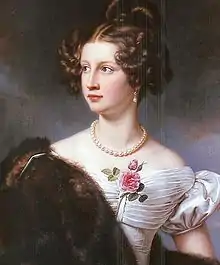 |
| Antonietta Cornelia Vetterlein | (1811–1862) | Reichsfreiherr Franz Ludwig Friedrich von Künsberg auf Hain-Schmeilsdorf (∞ 1843) | 72,5 x 59,2 cm | 1828 |  |
| Charlotte von Hagn | (1809–1891) | Alexander von Oven, Gutsbesitzer (∞ 1848) | 73,2 x 59,5 cm | 1828 |  |
| Nanette Kaulla | (1812–1876) | Salomon Heine, banker (∞ 1834) | 72,2 x 59 cm | 1829 | 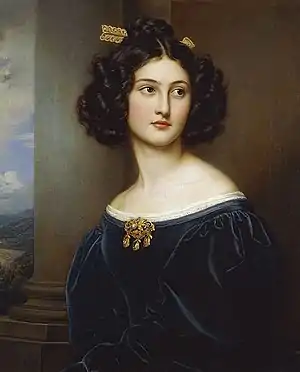 |
| Anna Hillmayer | (1812–1847) | 71,7 x 58,4 cm | 1829 |  | |
| Regina Daxenberger | (1811–1872) | Heinrich Fahrenbacher (∞ 1832) | 70 x 58,9 cm | 1829 | 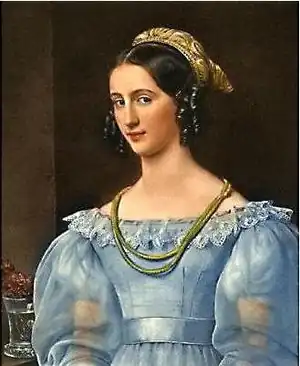 |
| Jane Elizabeth Digby | (1807–1881) | Edward Law, 1st Earl of Ellenborough (∞ 1824–1830) Freiherr Karl von Veningen-Ulner (∞ 1834) |
72 x 58 cm | 1831 |  |
| Marianna Marquesa Florenzi | (1802–1870) | Ettore Marchese Florenzi Charles Waddington |
71,6 x 58,4 cm | 1831 |  |
| Amalia von Schintling | (1812–1831) | Fritz von Schintling (betrothed, died before the wedding) | 72 x 58,5 cm | 1831 | 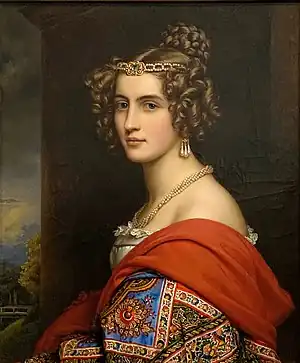 |
| Helene Sedlmayr | (1813–1898) | Kammerlakei Miller (from 1832) | 71,4 x 58,2 cm | 1831 |  |
| Marquise Irene of Pallavicini | (1811–1877) | Count Alois Nikolaus von Arco auf Steppberg (son of Maria Leopoldine von Österreich-Este), later divorced | 72 x 58,2 cm | 1834 | 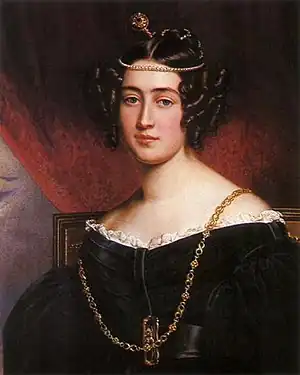 |
| Caroline von Holnstein | (1815–1859) | Count Theodor von Holnstein aus Bayern (∞ 1831) Freiherr Wilhelm von Künsberg von Fronberg (∞ 1857) |
71,5 x 58 cm | 1834 |  |
| Princess Crescentia of Öttingen-Öttingen and Wallerstein | (1806–1853) | Louis of Oettingen-Wallerstein (∞ 1823) | 72 x 58 cm | 1836 | 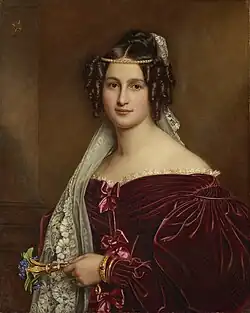 |
| Jane Erskine | (1818–1846) | James Henry Callander, Esquire of Craigforth (∞ 1837) | 72 x 57,9 cm | 1837 | 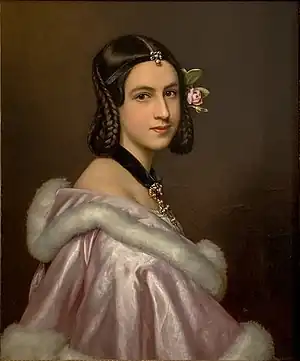 |
| Lady Theresa Spence (née Renard)[9] | (1815–?) | 72 x 57,8 cm | 1837 |  | |
| Mathilde von Jordan | (1817–1856) | Freiherr Friedrich Ferdinand von Beust (∞ 1843) | 72 x 59 cm | 1837 | .jpg.webp) |
| Wilhelmine Sulzer | (1819–?) | Karl Schneider, registrar (∞ 1838) | 72 x 59 cm | 1838 |  |
| Luise von Neubeck | (1816–1872) | Abbess of the Heilig-Geist-Spitals (1870–1872) | * Missing since 1936 | 1839 |  |
| Antonia Wallinger | (1823–1893) | Friedrich von Ott (∞ 1860), regierungsrat | 72,3 x 58,8 cm | 1840 | 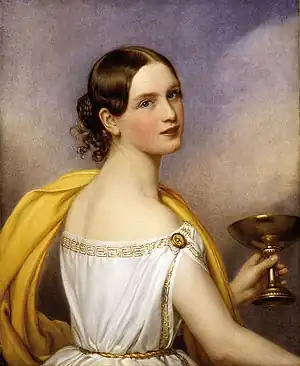 |
| Rosalie Julie von Bonar | (1814–?) | Freiherr Ernst von Bonar etc. | 72 x 58,2 cm | 1840 | 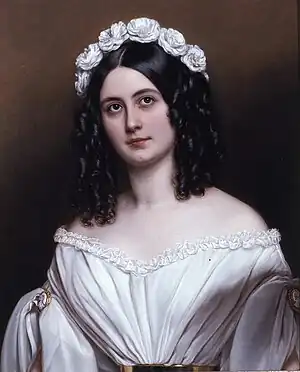 |
| Princess Sophie of Bavaria | (1805–1872) | Archduke Franz Karl of Austria (∞ 1824) | 72 x 59 cm | 1841 | 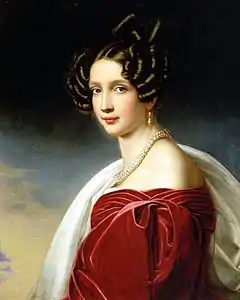 |
| Katharina Botsaris | (1820–1872) | Prince Georg Karadja (∞ 1845) | 72,4 x 59 cm | 1841 |  |
| Caroline Lizius | (1825–1908) | Karl Albert Joseph von Stobäus (∞ 1849) | 71 x 59,4 cm | 1842 |  |
| Elise List | (1822–1893) | Gustav Pacher, from Vienna (∞ 1845) | 70,3 x 59,2 cm | 1842 | 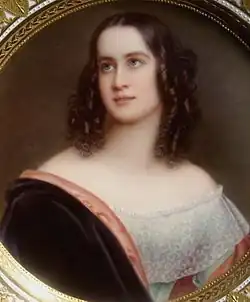 |
| Marie Friederike of Prussia | (1825–1889) | Crown Prince Maximilian II of Bavaria (∞ 1842) | 71,7 x 58 cm | 1843 | .jpg.webp) |
| Friederike von Gumppenberg | (1823–1916) | Ludwig Freiherr von Gumppenberg, her cousin (∞ 1857) | 70 x 59,4 cm | 1843 |  |
| Caroline von Oettingen-Wallerstein | (1824–1889) | Count Hugo Philipp von Waldbott-Bassenheim (∞ 1843) | 71 x 59,5 cm | 1843 | .jpg.webp) |
| Emily Milbanke[10] | (1822–1910) | Sir John Milbanke, British envoy in Munich (∞ 1843)[11] | 71 x 59 cm | 1844 |  |
| Josepha Conti | (1823–1881) | Anton Conti (∞ 1840, soon abandoned her) | 71,5 x 58,5 cm | 1844 | 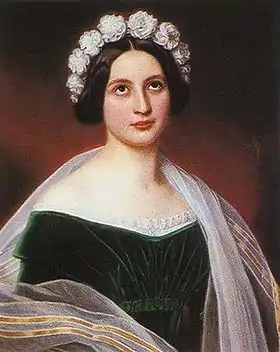 |
| Alexandra Amalie of Bavaria | (1826–1875) | 70,5 x 59,2 cm | 1845 | .jpg.webp) | |
| Archduchess Auguste Ferdinande of Austria | (1825–1864) | Prince Luitpold von Bayern (∞ 1844) | 70,2 x 59 cm | 1845 |  |
| Lola Montez | (1821–1861) | Thomas James, army officer 3 others |
72 x 58,6 cm | 1847 | .jpg.webp) |
| Maria Dietsch | (1835–1869) | Georg Sprecher, Chefredakteur der Augsburger Abendzeitung (∞ 1865) | 73 x 59 cm | 1850 | 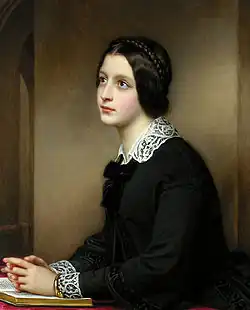 |
| Anna von Greiner | (1836–?) | Emil von Greiner (von 1861–1865) | 1861 | 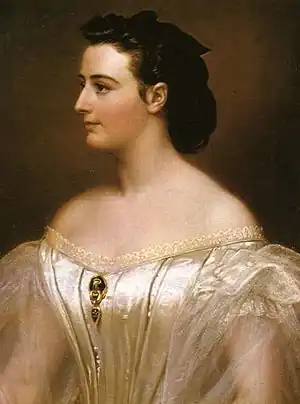 | |
| Carlotta von Breidbach-Bürresheim | (1838–1920) | Count Philipp Boos zu Waldeck (∞ 1863) | vor 1863 | 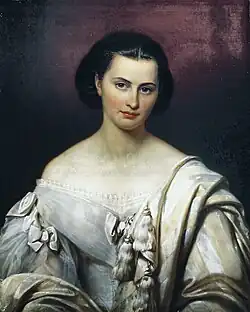 | |
Reception
In the 1840s, Heinrich Heine wrote the following lines in his praises of King Ludwig about Ludwig I and his gallery of beauties:
He loves art
and the most beautiful women,
as an art eunuch.[12]
he has them portrayed;
He walks in this painted seraglio
Moritz Gottlieb Saphir published the poem The Two Roses in February 1828, which deals with the portrait of Amalie Adlerberg.
References
- ↑ S. K. Ludovic, "A King's Gallery of Beauty" Strand Magazine (January 1902): 16–23.
- ↑ Die 37 Schönheiten von Nymphenburg, https://museen-in-bayern.de/schoenheitengalerie-schloss-nymphenburg
- ↑ "Castel Carnasino, Como". Lombardia Beni Culturali [Cultural Heritage of Lombardy]. Retrieved 31 October 2023.
- ↑ Küsse für den Fuß der Venus. Monumente online, Dezember 2007; abgerufen am 4. Februar 2008.
- ↑ Hans Reidelbach: König Ludwig I. von Bayern und seine Kunstschöpfungen, 1887/1888, S. 231
- ↑ Gebhardt, Heinz (November 8, 2012). "Als die Oper mit Bier gelöscht wurde: Münchner Bilder und Geschichten von 1158 bis heute". Stiebner Verlag GmbH – via Google Books.
- ↑ "golfsengct.de". Archived from the original on 2016-03-05. Retrieved 2023-09-11.
- ↑ Egon Cesar Conte Corti: Ludwig I von Bayern, 1937 zitiert In: Gerhard Hojer: Die Schönheitsgalerie König Ludwigs I. 2. neugestaltete Auflage 1973, Schnell & Steiner, München. S. 19/20 und S. 70.
- ↑ "Haus der Bayerischen Geschichte – Königreich – Lady Theresa Spence geb. Renard (1837)". Haus der Bayerischen Geschichte. Retrieved 2023-10-30.
Von der Porträtierten ist nicht viel bekannt. Auf der Rückseite des Gemäldes, das 1836/37 hergestellt wurde, steht zu lesen: 'Theresa Spence geb. Renard erblickte das Licht der Welt zu Florenz den 18ten Oktober 1815.' [Not much is known about the person portrayed. On the back of the painting, which was made in 1836/37, it reads: 'Theresa Spence née Renard saw the light of day in Florence on the 18th of October 1815.']
- ↑ Third daughter of the Earl of Mansfield.
- ↑ Their son John was also an envoy .
- ↑ Heinrich Heine, Gedichte/Nachlese/Zeitgedichte – Lobgesänge auf König Ludwig: 1. Das ist Herr Ludwig von Bayerland. zeno.org, abgerufen am 30. Mai 2008
External links
 Media related to Schönheitengalerie at Wikimedia Commons
Media related to Schönheitengalerie at Wikimedia Commons